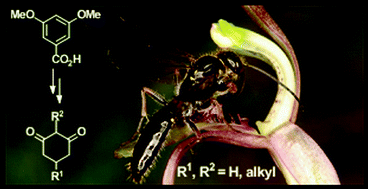(Z)-5-Tetradecen-1-ol, mw 212.37, formula C14H20O CAS 40642-42-0
Odorant receptors, present on nasal sensory neurons, perceive volatile compounds and regulate animal behavior such as reproduction. The nature of the ligands interacting with these receptors is, however, largely unknown.
Keiichi Yoshikawa and colleagues, University of Tokyo, Japan, shed new light on this issue. The researchers demonstrated that, in mice, preputial gland cells generate and secrete into the urine the unsaturated aliphatic alcohol (Z)-5-tetradecen-1-ol (pictured). This compound is regulated by the male hormone testosterone and acts as a natural agonist of the mouse odorant receptor Olfr288, affecting attractiveness to female mice. The urine of males lacking (Z)-5-tetradecen-1-ol, in fact, failed to attract females.

By identifying a novel receptor-ligand interaction in the mouse olfactory system, this study offers new insights into the complex chemistry regulating reproductive behavior.
- An unsaturated aliphatic alcohol as a natural ligand for a mouse odorant receptor,
K. Yoshikawa, H. Nakagawa, N. Mori, H. Watanabe, K. Touhara,
Nature Chem. Biol. 2013.
DOI: 10.1038/nchembio.1164 - Ohloff, G. et al. 1977. Helv. Chim. Acta. 60:1161-1174.
- http://www.cas-msds.com/40642-42-0
-
Bestmann, H.J., Brosche, T., Koschatzky, K.H., Michaelis, K., Platz, H., Vostrowsky, O., and Knauf, W. 1980. Pheromone XXX. Identifizierung eines neuartigen pheromonkomplexes aus der graseule Scotia exclamationis. Tetrahedron Lett. 21:747-750. Kelkar, S.V., Reddy, G.B., and Kulkarni, G.H. 1989. Indian J. Chem. Sect. B. 28:980-981. Ohloff, G., Vial, C., Näf, F., and Pawlak, M. 1977. Stereoselective syntheses of the isomeric 5, 10-pentadecadienals. Helv. Chim. Acta. 60:1161-1174. 

The Australian orchid Chiloglottis trapeziformis' very existence hinges upon there being some truth to the old adage that love is blind. Unlike other flowers, which lure pollinators with nectar, C. trapeziformis attracts its pollinator, the thynnine wasp Neozeleboria cryptoides, by producing the same pheromone that the insects use to attract the opposite sex–a practice known as sexual deception. Fooled by the pheromone, the male wasp will try to mate with the orchid. But ultimately it leaves the encounter with nothing more than a fine coat of pollen that it carries to its next liaison with a sexually deceptive orchid.
A five-step synthesis of monoalkyl- and 2,5-dialkyl-1,3-cyclohexanediones (1) is described viaa sequence involving sequential Birch reductions and alkylations from the readily accessible and inexpensive starting material, 3,5-dimethoxybenzoic acid. Two approaches were considered in which alkylation at C-2 occurs either prior or subsequent to the proposed reduction. The successful route, in which Birch reduction of a 3-alkyl resorcinol derivative (3) precedes alkylation was applied in the synthesis of chiloglottone 1 (1dc), in 58% overall yield.
(2-ethyl-5-propylcyclohexan-1,3-dione),
DOI: 10.1039/B912233H

Identification of the First Alkenyl Chiloglottone Congener

Chiloglottone 4, a plant allomone and insect pheromone, has been identified through synthesis. Field studies have shown it to be the biologically potent floral volatile in the orchid Chiloglottis turfosa attracting the wasp pollinator Neozeleboria sp.
http://onlinelibrary.wiley.com/doi/10.1002/ejoc.201200795/abstract
]]>